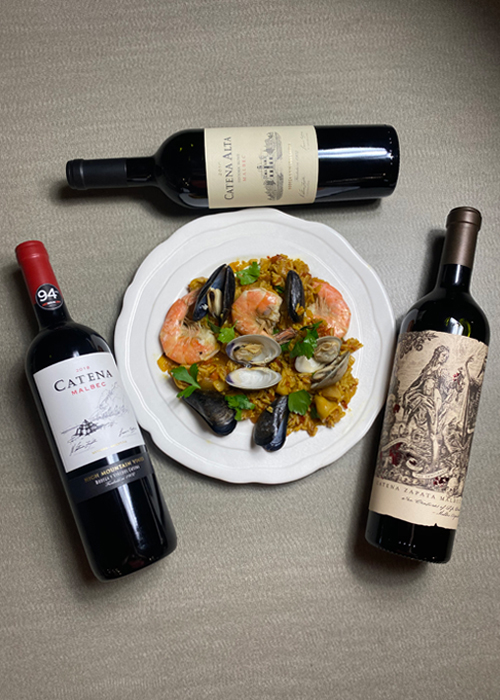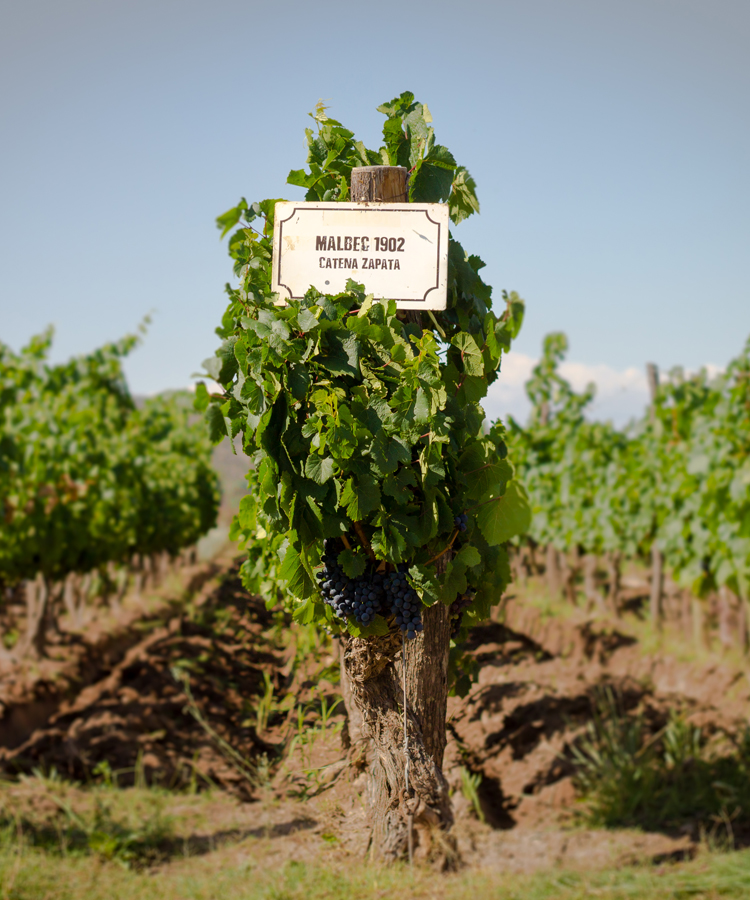
It’s impossible to find a grape that pleases every palate, but if we were going to throw one into the ring, it would definitely be Malbec. Fruit-forward, full-bodied, and with soft tannins, there’s no resisting Malbec’s allure, and the versatile variety is not only an easy, elegant accompaniment to a rich meal (think skirt steak or beef stew) but also an excellent wine to sip solo, too.
Malbec in 60 Seconds:
- Malbec is one of six grapes allowed in a red Bordeaux blend.
- Today, more than 75 percent of the world’s Malbec comes from Argentina.
- Plantings of Malbec in Argentina have increased by 171 percent since 2000.
- Mendoza is home to 85 percent of Argentina’s Malbec plantings, with quality expressions coming from higher-altitude sub-regions.
While Malbec has (literal) roots in France, it was Argentina that really brought this gorgeous grape to the world stage; it’s become the country’s flagship variety. That’s largely thanks to industry pioneers such as Nicolás Catena Zapata of Argentina’s Catena Zapata, who, through research, experimentation, and the exploration of a new type of terroir, took Malbec to the next level, turning a national favorite into a global phenomenon.
We invite you to pour a glass of Catena Malbec, learn more about this fascinating grape, and find some inspiration via tasty pairings from VinePair’s wine-loving staffers.
French Evolution: The Origins of Malbec
A 2,000-year-old variety, Malbec is a grape ripe with history. Malbec originated in Cahors, France, where it was first identified by Roman soldiers who were passing through the region. As time passed, the wine went on to become a favorite of famous figures such as Eleanor of Aquitaine, and later Francis I, who referred to Malbec as les plantes du roi (“the king’s plants”). He had the vines planted across the country, from Fontainebleau to Burgundy. With this ringing royal endorsement, Malbec made its move to the region of Bordeaux, where it has been used as a blending agent to soften Cabernet Sauvignon’s harsher tannins ever since.
When phylloxera (a grapevine’s insect enemy) decimated vineyards across Europe in the late 19th century, French growers were forced to start over and many growers, especially in Bordeaux, opted to replace Malbec — a risky, late-ripening grape that didn’t always respond well to the region’s cold, wet climate — with safer bets such as Cabernet and Merlot. So as time passed and the wines made from these other grapes gained global stature, Malbec — though still very present in various corners of its country of origin — never quite did.
The Catena Zapata Malbec Argentino, one of our favorites, illustrates this thousand-year history of Malbec on its label — including a depiction of Eleanor of Aquitaine — as well as the grape’s very different (and successful!) story across the Atlantic.
Why Malbec Thrives In Argentina
When Argentine winemakers were searching for a grape to improve the quality of their wines in the 1850s, they sought the advice of French agronomist Michel Pouget, who brought over a variety of vines from France, including Malbec.
The grape found its ideal home in Argentina’s mountainous landscape; the experiment was more of a success than winemakers could have imagined. In regions like San Juan, Salta, and especially Mendoza — the beating heart of Argentina’s wine industry —Malbec didn’t just survive, it thrived, and by 1962 there were nearly 60,000 Malbec vines planted across the country.
Since its introduction to Argentina, Malbec has become the country’s claim to wine fame, with producers such as Catena Zapata —this year named the world’s most admired wine brand — and its wines earning global recognition.
Why High Altitude Malbec Is So Great
While Argentina is home to a variety of terroirs, we can’t discuss Argentine Malbec without mentioning the not-so-secret weapon responsible for its success: the Andes’ extremely high altitudes.
In the Andean foothills of Mendoza, vineyards are located high above sea level, with an average elevation in the range of 2,000 to 3,600 feet. This setting is a far better fit for the delicate, thin-skinned Malbec grape, which thrives in cool, dry climates and requires good sunlight to fully mature. As one ascends the mountains, the average temperature decreases, while the amplitude between day and night temperatures increases, impacting the quality of the fruit and offering a more exciting range of richness, textures, and aromas.
It’s for this reason that Nicolás Catena Zapata set his sights (and his sites!) on these great heights, not only planting grapes at the average Mendoza altitudes but also making it his mission to raise the Malbec bar — to 5,000 feet above sea level, to be exact.
While this vineyard in the sky makes a good story (and great wines), it’s also representative of something even bigger: Nicolás’s quest to master Malbec — and share Argentinian wine with the world.

Thirst for Knowledge
The family-owned winery dates back to 1902, but when Nicolás began running it in the mid-‘60s, a new era of experimentation began. The history from that point is divided into three revolutions, during which new methods and knowledge have been discovered and applied, new milestones — and altitudes! — have been achieved, and a wonderful array of excellent wines have been produced. The limited-production Catena Alta single varietals, for instance, include the first super-premium varietal Malbec to be exported worldwide from Argentina.
Nicolás knew that he was on to something and continued looking upward, to even higher elevations, intensely studying the extreme limits of vine cultivation, and following his dream: to create wines that can stand with the very best.
While viticulturists were skeptical that Malbec would succeed in this environment, Nicolás’s big (though very educated) bet on the terroir’s potential paid off. In Catena’s extreme-high-altitude Adrianna Vineyard — “South America’s Grand Cru” — the limestone-rich topsoil, misty mornings, cooler temperatures, and brighter sun (which makes for thicker grape skins, and thus heightened tannins) resulted in wines with more structure, acidity, and complexity, including three outstanding Malbecs.
Quality Through Science
Today, with Argentine Malbec more appreciated than ever and Catena Zapata at the top of its game, the Catena family’s never-ending quest for improvement continues through the Catena Institute of Wine, founded by Nicolás’s daughter, Dr. Laura Catena. In addition to fourth-generation vintner and managing director of the winery, Laura is also a physician, biologist, and author —and hence her goal: to use science to even better understand Mendoza’s high-altitude terroir and all that it has to offer. “At the institute,” says Laura, “a team is dedicated to studying every meter, every rock, every insect, and microorganism in the Adrianna Vineyard,” further exemplifying the family’s ongoing commitment to elevate Argentine wine in the world.
+ A Taste of Argentina: The Best Malbec Food Pairings from the VinePair Team
Three of our editors had the opportunity to enjoy a tasting of Catena wines led by Laura. (The conversation was virtual — the wine, of course, was not.) Here are a few takeaways and tips from our lucky team members, who each took a different bottle of Catena Malbec into their respective kitchens and cooked up some perfect pairings:
Jason Russell on Catena Alta Malbec 2016:

“After hearing Laura talk about the history of the region, the company, and the wine, it was clear that I would be pairing the Catena Alta with a beef dish to capitalize on its bold flavors. Initially, I thought of making a traditional steak with chimichurri, but instead opted for braised short ribs. Here’s why: Catena’s passion for family comes through in their wine and this dish is ideal for a family dinner or gathering with friends. Also, since it’s in the oven for 2.5 to 3 hours, there’s plenty of opportunity to relax and enjoy a glass or two while you wait. Once out of the oven, the tender, juicy meat falls right off the bone and pairs perfectly with the bold, deep flavors of the Malbec.”
Tim McKirdy on Catena Zapata Malbec Argentino 2017:
“Learning the historic background of this wine and its label, I was inspired to pair Catena’s Argentino Malbec with a simple but classic Argentine staple: empanadas.
I’m the type of cook who enjoys a project — especially for Saturday night dinner. It’s the perfect excuse to open the bottle early, start to let it breathe, and enjoy a glass while preparing the food. Tasting the layers of fruit and minerals in this wine, which showcase the unique terroir of Mendoza’s Valle de Uco, I knew I was in for a treat.

The pairing didn’t disappoint: The wine’s generous acidity and pleasant tannins offered the perfect match for the crispy baked empanada dough and the tender spiced beef filling within. Malbec enjoys a reputation as a food-friendly wine for a reason. But when the bottle’s this good, pairing with something as simple as empanadas really allows its complexity to shine.”
Katie Brown on Catena Malbec 2018:
“I had always thought of Malbec as a big steak wine, and since I’ve been a pescatarian since age 7, I had never been sure of what to pair it with. But Laura’s presentation made me realize that Malbec pairs well with a variety of dishes — from tamales to Milanese. I decided to pair Catena’s High Mountain Vines Malbec with seafood paella, because I thought the richness of the dish would be able to stand up to the Malbec.
This pairing definitely proves that Malbec can pair with so much more than just red meat. This balanced wine was the perfect match for the floral, spicy flavors of the paella.

I also enjoyed tasting Catena Zapata Malbec — the label of which was inspired by generations of women — with my mom. I can’t wait to share a meal and great wine like this with the other women in my family who live across the country.”
This article is sponsored by Catena Wines.

